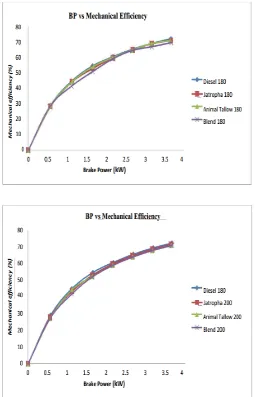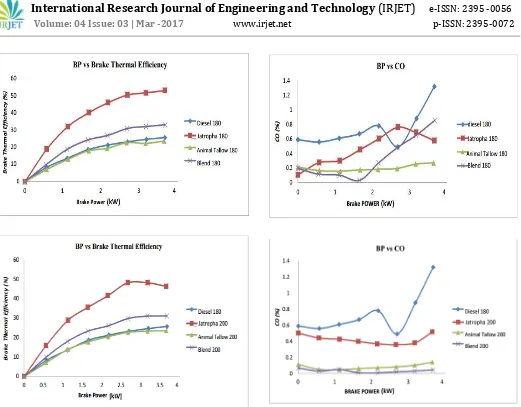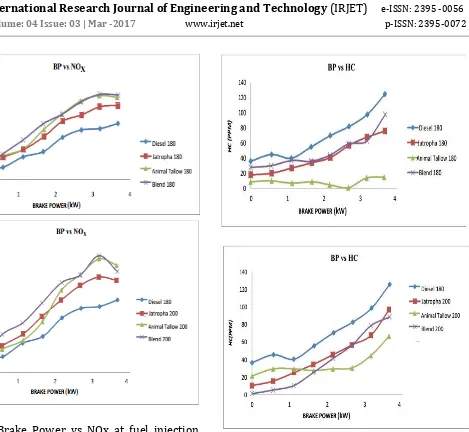© 2017, IRJET | Impact Factor value: 5.181 | ISO 9001:2008 Certified Journal | Page 410
Experimental investigations on performance and emission
characteristics of diesel engine using bio-diesel as an alternative fuel
Syed Azam Pasha Quadri
1, Sarap Raghavendra
2, Shamsad Alam
3, Faraaz Masiuddin Siddiqui
41Professor and H.O.D of Mechanical Engineering Department, Lords Institute of Engineering & Technology,
Hyderabad
2Assistant Professor of Mechanical Engineering Department, Lords Institute of Engineering & Technology,
Hyderabad
3,4Students of Mechanical Engineering Department, Lords Institute of Engineering & Technology, Hyderabad
---***---Abstract
In India petro-diesel is a crucial fuel to drive many sectors such as Transportation, Agriculture, Power generation etc. Ever since the invention of IC Engine in particular CI Engine many improvements have taken place in engine design by varying both designs and operating parameters. This scarcity of conventional fuels and their pollutants generated by combustion have become serious concern about the alternate fuels. From the previous researchers it is learnt that the solo bio-diesels have given fruitful results which are closure to conventional fuels such as diesel. In this work the composites blends are used by considering the properties of Bio-diesel jatropha and animal Tallow. The experimental investigation are carried out on a single cylinder 4-strokes CI diesel Engine, water cooled, Coupled with loading device of eddy current dynamometer. From the experiments conducted, both biodiesels and their blend are similar to that of diesel in terms of performance without any modifications of engine. The highest Mechanical efficiency is for diesel is 72.3% at full load condition at injection pressure of 180bar. The maximum heat input is 15.42% for animal tallow biodiesel at full load condition of 180bar. The emission of CO and HC of Biodiesels and their blends is less than diesel. But the NOx emission of biodiesel and their blends are high when compared with diesel, this is due to the large amount of inherent oxygen in biodiesel.
Keywords
Biodiesel; Performance; Combustion; Emissions; Jatropha; Animal Tallow; Dual fuel.
1. Introduction
In one of the most historical controversies on biodiesel, some of the researchers claim that Rudolph Diesel fuelled one of his early engines with peanut oil at the Paris Exhibition in 1900. In 2005 b Knothe, prepared a comprehensive review of the literature available from the Diesel era. His work concluded that Diesel did not actually use peanut oil himself but was describing a test conducted by another company. In any case, the vegetable Oil experiment was considered to be a
© 2017, IRJET | Impact Factor value: 5.181 | ISO 9001:2008 Certified Journal | Page 411 properties of different vegetable oils and modified fuels
for automotive applications have acceptable cetane numbers (60-65), high viscosity (50 Cst), high flash points (220-285 0C) and high pour points (-6 to 12 0C) and appreciable heating values (about 90 % of diesel) and low sulfur content (< 0.02%).The first known report of using esters of vegetable oils as a motor fuel was described in a Belgian patent granted to G. Chavanne of the University of Brussels on 31 August 1937. The first report on use of esters in the U.S. was evidently by Fort et al. (1982), reported in an SAE paper titled, “Evaluation of Cottonseed Oils as Diesel Fuel.” This study was closely followed by two other important studies on using ester fuels, Geyer et al. (1984) and Wagner. These early studies concluded that a significant factor that slowed development of vegetable oil esters was cost. In the 1980s vegetable oils were considerably more expensive than diesel and it was mentioned that the additional processing would only drive the cost higher. The overall theme and outcome of the 1982 ASME conference was that raw vegetable oils, while showed promise had a issues related to injector coking, polymerization in the piston ring belt area resulting in stuck or broken piston rings, and a tendency to thicken of lubricating oil leading to sudden and catastrophic failure of the rod or crankshaft bearings. It was learnt that transertification process helps in reducing the viscosity of vegetable oil and also its tendency of polymerization. In 1984, Ziejwski fueled engine with sunflower derived biodiesel. In 1984, Shrinivasan and Gopal Krishnan used Karanja based bio-diesel. Schumacher was the first of the many researchers to report the ability of Biodiesel to reduce smoke density, in the year 1992. During 1977, Christopher Daniel of Chicago conducted two tests using biodiesel as fuel. The test results proved that the biodiesel could be used as a feasible alternative fuel.In the works carried out by the researchers, M. Senthil Kumar, T. Ganapathy and P.Ravi Kumar has proved that methyl ester of Jatropha oil could be considered as fuel and showed that transesterfication reaction improved the properties of the ester. In the experiments conducted by Masjuki and Prasad using esterifed Palm oil to conduct experiments on diesel engine has proved that Torque, Brake Power, Specific Fuel Consumption and Brake Thermal Efficiency were found comparable to that of diesel fueled engine.
In 2003, Lin and Wang of China used Emulations as fuel for diesel engines, because of their ability to reduce
the usage of waste oil biodiesel as the alternative. The exhaust emission characteristics of diesel engines operated with biodiesels have been studied by many researchers, across the globe. A review of research papers of Quick, Baric and Lhumke revealed that with the use of biodiesel the harmful exhaust emission particularly CO and sulphur compounds are reduced as compared to mineral diesel operation. Prasad and R. Mohan have studied the effect of super charging using biodiesel of Cotton Seed Oil on diesel engine. In the year 2007, M.A. Rahman has concluded that Mahua based biodiesel can be safely blended up to 20% with mineral diesel and could be a used as alternative fuel. In contrast, several researchers (Rahman, Phadtare 2004, K. Agarwal 2001, Md. NorunNubi 2006, He Bao and Hamelinck) have observed that the exhaust emissions are affected by the use of biodiesel. It is known that biodiesel generally causes on increase in NOx emission and decrease in unburned hydrocarbon (HC), CO and particulate matter, emission when compared with diesel emissions. There are reports related to study of performance and emissions characteristics of diesel engine fuelled on blends Karanja biodiesel and Neem biodiesel optimizing the relevant working parameters.
2. Experimental setup and procedure
© 2017, IRJET | Impact Factor value: 5.181 | ISO 9001:2008 Certified Journal | Page 412
Fig.2
Engine setup and Instrumentation.
Table.1
Specification of test engine
Sl.
No
Specifications
Kirloskar
Number
of
cylinders
One
Bore× Stroke(mm)
87.5 × 110
Cylinder
Diameter(mm)
87.5
Stroke Length(mm)
110
Compression Ratio
17.5 : 1
Orifice
Diameter(mm)
20
Connecting
rod
length(mm)
238
Rated Power(kW)
5.2 @1500 rpm
Swept Volume(cc)
661
Clearance
Volume(cc)
38.35
Type
of
combustion
Chamber
Hemispherical
open
combustion
chamber
2.1 Methodology
The biodiesel of Jatropha is supplied by the Online Southern Biodiesel, Bangalore. The biodiesel of Animal Tallow is supplied by the Online Southern Biodiesel, Hyderabad. The engine is first started by using Diesel as a fuel at injection pressure of 180 bar and the operating characteristics and emissions such as Carbon Monoxide (CO), Hydrocarbons (HC) and Nitrous Oxide (NOx) of the engine from the exhaust gas are noted down. The obtained results of diesel are standard parameters and are used for comparison of performance and emissions of biodiesels and their blend. The engine is then runned by Jatropha biodiesel at an injection pressure of 180 bar. The engine after starting is allowed to run for 10-15 minutes to reach steady state conditions before noting the readings. After the steady state conditions are achieved the observations are made for incremental loads ranging from no load to full load.
© 2017, IRJET | Impact Factor value: 5.181 | ISO 9001:2008 Certified Journal | Page 413
injection pressure of 180 bar and allowed to run for
10-15 minutes in order to obtain steady state conditions.
Then the readings of the inlet air flow rate, the time for 10 cc of fuel consumption, the ambient temperature, the exhaust gas temperature, the outlet cooling water flow rate, the temperature readings and the five emissions such as CO, HC and NOx from the gas analyzer are noted are down. The experiments are carried out by following the same steps at injection pressures of 200, 220 and 240 bar respectively and the readings are tabulated. The biodiesels of jatropha and animal tallow have densities close to each other and hence they are directly mixed. The blend is prepared just before test to ensure mixture homogeneity on volume basis from 0% to 100% volume of biodiesel at room temperature. The blend is prepared by adding two litres of jatropha biodiesel to two litres of animal tallow biodiesel. The blend prepared is then supplied to the fuel tank after ensuring the tank is empty and clean.
Then engine is started at 180 bar and is kept ideal at zero load, till the steady state conditions are reached. The above mentioned observations are recorded at injection pressures of 200, 220 and 240 bar respectively at each load.
3.Results and Discussion
The results obtained from the experiments of Jatropha
biodiesel, Animal Tallow biodiesel and their blends at injection pressures of 180, 200, 220 and 240 bar are compared and discussed with respect to the results when the engine is fuelled with diesel at injection pressure of 180 bar. The reason for taking the results of diesel at 180 bar is that these results are considered to be standard for CI diesel engines throughout the globe.3.1 Performance
3.1.1Mechanical Efficiency
The mechanical efficiency of different fuels is
shown as function of brake Power. The mechanical efficiency of all the fuels is seen to increase with increase in brake Power. [image:4.595.307.562.139.536.2]From the below figures the mechanical efficiency of biodiesels and the blend are lower than diesel at four injection pressures showing the poor performance
Fig 3.1.1
Brake Power vs Mechanical Efficiency at
fuel injection pressure of 180, 200, 220 & 240 bar
respectively.
3.1.2Brake Thermal Efficiency
From the below figures it is observed that brake thermal efficiency of Jatropha biodiesel and the blend is higher than brake thermal efficiency of diesel at all injection pressures.
© 2017, IRJET | Impact Factor value: 5.181 | ISO 9001:2008 Certified Journal | Page 414
Fig 3.1.2.
Brake Power vs Brake Thermal
Efficiency at fuel injection pressure of 180, 200,
220 & 240 bar respectively.
3.2 Emissions
3.2.1 CO emissions
The below graph shows the variations of CO emission with brake Power. It is seen that CO emissions are increased with increase in brake Power. It is observed that the CO emissions of biodiesels and their blends are far below the emissions of diesel at all injection pressures. The lower CO emission of biodiesels and their blends are due to high oxygen content of biodiesel which helps in complete oxidation of fuel.
Fig 3.2.1
Brake Power vs CO at fuel injection
pressure of 180, 200, 220 & 240 bar respectively.
3.2.2 NOx emissions
The NOx values as parts per million are plotted as function of brake Power. From the figure it is observed that the emissions of biodiesels and their blends are high compared with that of diesel at all injection pressures.
[image:5.595.40.561.47.454.2]© 2017, IRJET | Impact Factor value: 5.181 | ISO 9001:2008 Certified Journal | Page 415
Fig 3.2.2
Brake Power vs NOx at fuel injection
pressure of 180, 200, 220 & 240 bar respectively.
3.2.3 HC Emission
The variations of HC emission for diesel, biodiesel and their blends are shown in the below figure. The HC emissions of diesel are higher compared to that of biodiesels and their blends at each load. This is because of high cetane number and increased gas temperature of biodiesel. The high cetane number decreases the ignition delay and the high temperature helps in preventing condensation of hydrocarbons, thus reducing the HC emissions.
Fig 3.2.3
Brake Power vs HC at fuel injection
pressure of 180, 200, 220 & 240 bar respectively.
4. Conclusions
In this work engine is runned by fuelling with Diesel, Jatropha Biodiesel, Animal Tallow Biodiesel and their Blends respectively. The engine performance and the emissions (CO, CO2, NOx, HC, and O2) are obtained at different loads at injection pressures of 180, 200, 220 and 240 bar respectively. From the results obtained the following conclusions are made.
[image:6.595.88.557.47.479.2] [image:6.595.37.300.73.457.2]© 2017, IRJET | Impact Factor value: 5.181 | ISO 9001:2008 Certified Journal | Page 416 maximum Brake Thermal Efficiency obtained is
53.12% for Jatropha biodiesel at full load condition, at an injection pressure of 180 bar and the engine speed at 1375 rpm. The brake thermal efficiency of jatropha and the blend is more than the brake thermal efficiency of diesel. The brake thermal efficiency of animal tallow is slightly less when compared with diesel at all assorted injection pressures.
The maximum CO and HC emissions are for diesel at full load condition. The CO and HC emissions of biodiesel and the blend are lower than diesel at all injection pressures. The maximum NOx emission is obtained for blend at an injection pressure of 240 bar, at full load condition. These emissions of blend and the two biodiesels are higher than diesel at all injection pressures. The exhaust emissions of CO and HC are reduced when compared with diesel emissions at all injection pressures.


